Table of contents
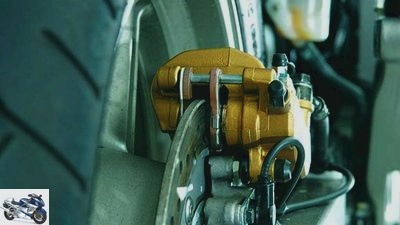
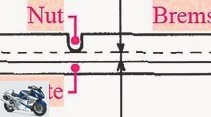
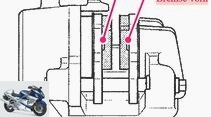
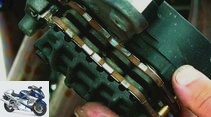
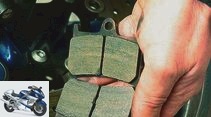
7th pictures
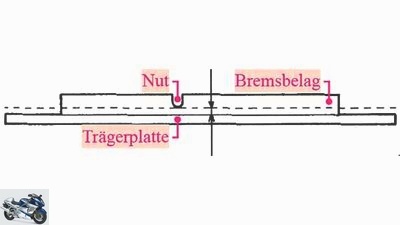
1/7
The groove is the wear indicator. If it can no longer be seen, the covering is only 1 mm thick. Or even thinner.

2/7
The variant with integrated, small wear grooves on the side of the brake pad is rather rare.
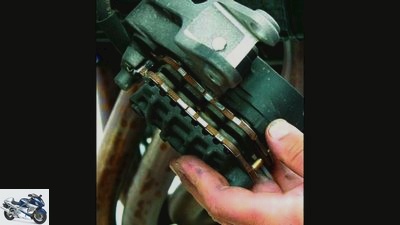
3/7
There is also single coverings on very large carrier plates without wear marks – there is only one thing that helps: a sense of proportion.
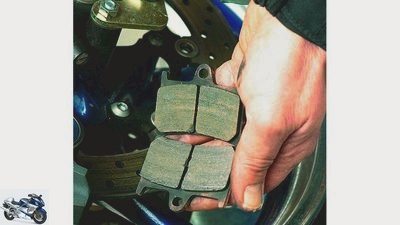
4/7
Groove in detail.
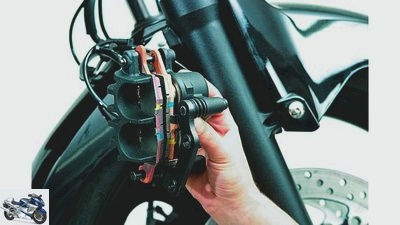
5/7
In the case of larger brake pads, several grooves are often milled in. This also prevents tension.
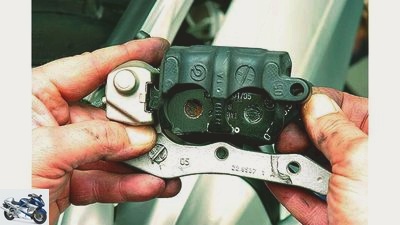
6/7
Sometimes there are also control bores: If the pavement is worn, you can see the disc.
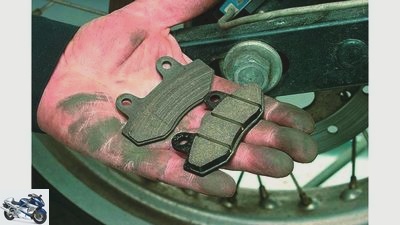
7/7
This is what a worn pad that is ready to replace looks like (left). The brand new replacement can be seen on the right.
counselor
technology & future
Check brake pads
Check brake pads
Still enough material on it?
A brake pad is small and inconspicuous and does its job in the dark. But it is indispensable, because without it it becomes dangerous and expensive. So your topping deserves some care. Read here how to check and correctly assess your brake pads.
Melanie Khoshmashrab
06/15/2011
Basics
If it scribbles and rasps from the brake, it is already too late: Then iron on iron brakes, the brake lining is worn, completely worn out, and the metal carrier plate of the brake pad presses directly and unmistakably on the brake disc.
You are lucky if you come to a stop in time and have not ruined the brake disc in the process – avoided an accident, saved at least 250 euros.
When the brake lever is actuated, the piston in the master brake cylinder builds up pressure in the brake fluid, which acts on the pistons in the brake caliper (“Brake piston”) is transferred. This causes the brake pistons to move out of their bores and press the brake pads against the rotating brake disc.
The friction between the lining and the disc brakes the wheel. Because the surface of the brake disc slides over the brake lining, both wear and tear, the brake disc less, but the brake lining even more. Rule of thumb for normal loads: a brake pad lasts about 25,000 to 30,000 kilometers, the brake disc about three times that distance.
The point “Check brake pads” can be found in the maintenance instructions of all manufacturers for every small and large inspection. However, since the maintenance intervals are now up to 12,000 kilometers, you should also pay a little attention to the brake pads themselves.
Attention
Check regularly whether the covering is still thick enough: it must be significantly thicker than a millimeter. A new brake pad is five to eight millimeters thick. Check the thickness of the brake pads on the front and rear wheels, especially in good time, before you set off on a longer tour. A sudden one “Scrap” going down a pass is not only embarrassing, but also life-threatening.
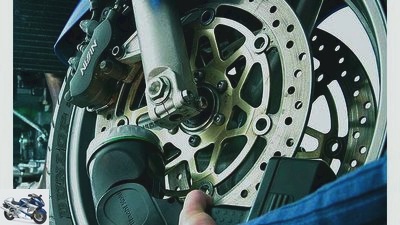
Head down and light on: For once, you should get on your knees to check the brake pads. A flashlight puts the brake blocks in the right light.
This is how it’s done Expanding and measuring is far too cumbersome and is not done this way in any workshop. You just have to get the right one “Sense of proportion” have – it is not difficult to distinguish one millimeter from five. Take a look at the drawing below on the left: This is what a brake block looks like in cross section.
The adjacent photos of the brake pads make the matter even clearer: The brake lining is attached to a carrier plate, mostly glued and additionally pressed on under high pressure. In order to be able to check the lining thickness, you need a little light: if you shine a flashlight or another light source along the brake disc, for example, you can see the brake pad. The brake pad is slightly smaller than the approximately three millimeter thick metal carrier plate.
There must be more than a millimeter of material between this and the brake disc – this is the brake lining. Most brake pads have wear marks. The photos below show the most common ones. A tip for anyone who does not have a good feeling for measurements and cannot see any wear marks on the brake pads of their machine: A match is 1.5 millimeters thick.
This must be able to be pushed between the brake pad carrier plate and the brake disc: If it fits and there is still enough space on the left and right, the brake pad is still sufficiently thick. If it doesn’t fit, the brake lining is already so thin (“gone”) that the brake pads should be changed as soon as possible. Advanced hobby mechanics can do it themselves, everyone else in the workshop usually doesn’t pay the world for it.
Related articles
-
Guide to changing the brake pads on the motorcycle
Ralf Schneider counselor workshop Guide to changing the brake pads on the motorcycle Change the brake pads on the motorcycle Tips from professionals…
-
jkuenstle.de counselor workshop Working on the drum brake Working on the drum brake Not only a disc brake needs care You are completely isolated from the…
-
Test sintered metal brake pads
Artist accesories Test sintered metal brake pads Test sintered metal brake pads Kept well Which sintered metal brake pads bring the bestselling Suzuki…
-
Change brake discs yourself – tips and tricks
Markus Jahn 9 pictures Ralf Schneider 1/9 There is a need for action here! The heat spots on the panes shown on the left can certainly no longer be…
-
Comparative test of sintered metal brake pads for Yamaha TDM 850
accesories Comparative test of sintered metal brake pads for Yamaha TDM 850 Comparative test of sintered metal brake pads for Yamaha TDM 850 Record…
-
Bilski counselor workshop Check motorcycle Basic motorcycle check Brief routine before the trip You never have time for some annoyances – unless you take…
-
Ralf Petersen counselor workshop Brake system screwdriver tips Brake system screwdriver tips Everything on stop If you want to move forward quickly, you…
-
counselor technology & future Technology: big brake test Technology: big brake test Fear eats up the soul Decreasing braking effect up to total failure -…
-
Third Eye Design InView: additional brake light for the helmet
Third eye design accesories Accessories A-Z Third Eye Design InView: additional brake light for the helmet Third Eye Design InView Additional brake light…
-
Advice: check and adjust steering head bearings
Cook 9 pictures Cook 1/9 Checking and adjusting the steering head bearing – Step 2: Loosen the central nut on the steering shaft. Only use a nut and a…